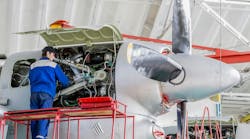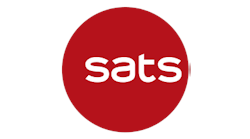Fall protection remains one of the most challenging aspects of maintaining a safe work environment, no matter the industry. The Occupational Safety and Health Administration (OSHA) releases an annual report for their “Top 10 Most Cited Violations” and fall protection violations reign as the supreme leader in citations each year. Additionally, the number of fatal injuries due to falls has increased each year since 2020.
The real tragedy this data reveals is that while fall deaths are so prevalent across many industries, all falls are preventable with proper education and training, coordination from building owners, and dedication to keeping workers safe.
To maintain compliance with federal OSHA standards, employers must provide fall protection for workers exposed to a fall of four feet or more. However, simply meeting minimum compliance leaves room for human error or equipment misuse that can still leave workers exposed to injury. It may not be the most convenient, affordable, or quickest way to provide fall protection, but focusing on providing overhead anchorages can be the key to saving lives.
ABCs of Fall Protection
A personal fall protection system is comprised of three components: the anchor, the body harness and the connection device. As long as a body harness fits a user correctly and is donned properly, it will keep the body upright in a fall and limit fall forces felt by the fall victim to under 1,800 lbs. And as long as minimum fall clearance is maintained for a connection device, per the manufacturer’s instructions, it will successfully decelerate the fall, absorb fall forces and arrest the fall. However, the location of a user’s anchor point can limit which connection devices are available for use and can vary the amount of fall forces that are incurred from a fall.
How Fall Forces Can Vary with Anchor Height
All falls occur differently, but fall forces are generated while the user is in a state of “free fall.” The longer a user is free falling, the more force will be generated and must be absorbed by the fall protection system. When using a shock-absorbing lanyard, freefall is virtually inevitable no matter the anchor location. The lanyard must be fully extended before the shock absorber can begin to deploy and absorb fall forces. Elevating an anchor point will equate to less free fall. Self-retracting lifelines (SRLs) have grown in popularity in recent years because they can also help limit free fall, thus decreasing total fall forces put on the system. With overhead anchorages, shock-absorption with an SRL activates the moment a fall occurs, or technically speaking, once the speed the lifeline dispenses from the unit accelerates to a certain threshold and the internal brake activates.
Anchor Height Affects Minimum Fall Clearance Calculations
Aside from limiting free fall distance and fall forces incurred, anchor height plays a factor in calculating minimum required fall clearances. Note, users must always consult a connection device’s instruction manual to verify the manufacturer’s specifications.
Here is one way to calculate the minimum fall clearance required for a 6-foot shock-absorbing lanyard:
Length of lanyard (6ft) +
Dorsal D-ring height (5ft) +
Typical harness stretch (1.5ft) +
Deceleration distance (4ft) +
Additional safety factor (2ft) =
18.5 ft of minimum fall clearance
With shock-absorbing lanyards, fall clearance should be measured at the anchor location. It is also important to note that fall forces are not fully absorbed until the fall is successfully arrested. If a worker makes contact with the ground before the fall is arrested, they are potentially subject to full fall forces. This is why adhering to minimum fall clearances is so important to avoid debilitating injuries.
To calculate minimum fall clearance for a common 6-foot SRL with an overhead anchorage:
Deceleration distance (3ft) +
Typical harness stretch (1.5 ft) +
Additional safety factor (2 ft) =
6.5ft of minimum fall clearance
Since SRLs can eliminate freefall in overhead applications, calculate minimum fall clearance from the user’s walking working surface. However, as the anchorage location lowers beneath the user’s dorsal D-ring, calculate the clearance from the anchor location and factor in the distance below the dorsal D-ring to accommodate for anticipated freefall. Note, the ANSI Z359 standard does not permit tie-off more than five feet below a user’s dorsal D-ring, which is foot-level for most users.
Overhead Anchorage Solutions
When it comes to ground handling tasks, the uncertain elements of a dynamic workplace can prove challenging to provide consistent, overhead anchorage locations. However, a focus on preventative action and an investment in modular equipment can prove effective in preventing fall injuries. OSHA’s mandate to provide fall protection is based on feasibility, not convenience or affordability.
There are primarily two types of overhead anchorage solutions: single-point and linear systems.
Single-point systems utilize individual anchorages to protect users. The general consensus is that users work no more than 6-8 feet away from an overhead anchor, as additional swing fall may occur. Swing fall can lead to increased fall distances due to the pendulum effect. In larger work areas, systems must contain multiple anchors for workers to connect along the work area to ensure they stay in-line with their anchor.
Linear systems utilize trolley systems that will adjust with the worker’s position, always keeping their connection device overhead. This allows for a wider range of motion and less physical input from the worker to remain safe at heights.
Unfortunately, most facilities are not constructed with end user fall protection in mind. Many organizations must retrofit building structures to accommodate overhead anchorages. While single-point anchor systems can be comprised of “off-the-shelf” products, they can restrict the range of movement for workers and be cumbersome to operate properly, as previously stated. Most indoor maintenance or repair jobs will require access to the entire aircraft at some point in the job and would benefit from overhead linear systems. In older facilities that might not meet the minimum structural requirements to install anchors, there are truss-based systems that can stand alone inside the facility. Again, these systems require detailed planning and logistics, but when lives are at stake, we must do what is necessary to keep workers safe.
For temporary or infrequent operations, portable anchor systems can be useful. These systems can typically be transported with a forklift or even towed by standard pickup trucks. Once placed in position, they can be erected to provide a single-point overhead anchorage for workers at height. For those who are wary of investing in equipment right away, many of these options are available to rent from manufacturers before permanent purchasing decisions are made.
Conclusion
Falls are far too common, and the existing solutions are feasible, simple-to-use and effective at keeping workers safe from falling. While any solution will have its benefits and drawbacks, providing an overhead anchorage for fall protection users gives business owners the best chance of success in mitigating injury and preventing fatality if a fall occurs.
Companies like Diversified Fall Protection can assess facilities for their structural integrity and capability, design custom fall protection systems, and provide turnkey solutions for organizations ready to further commit to the safety and well-being of their workers.
Efforts made now to create safer work environments can prevent injuries and save lives in the future.



